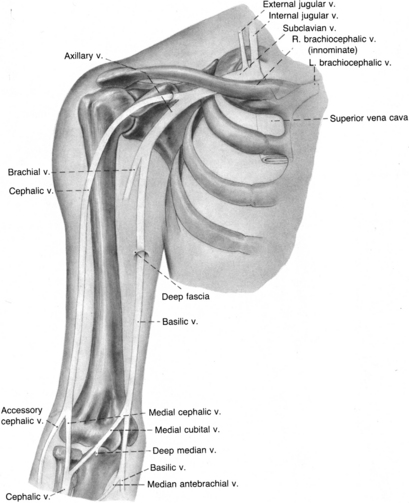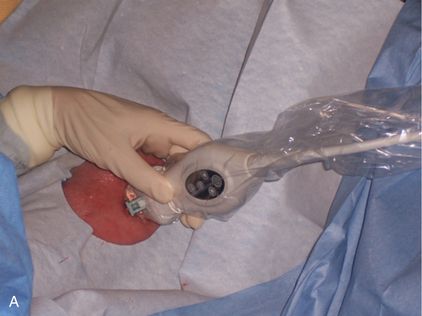 Peripherally Inserted Central Catheter
Peripherally Inserted Central Catheter
PREREQUISITE NURSING KNOWLEDGE
• Successful completion of specialized education in peripherally inserted central catheter (PICC) insertion and demonstrated competency are necessary.5,6 In addition, opportunities to demonstrate clinical competency on a regular basis (e.g., yearly) may be needed.
• Clinical and technical competence is needed in suturing PICC lines in place (if permitted by registered nurse [RN] in state of practice).
• Sterile technique should be understood.
• Knowledge is necessary of the anatomy and physiology of the vasculature and adjacent structures in the upper extremity, neck, and chest.
• Ideally, the patient receiving a PICC should have a peripheral vein that can accommodate a 14- or 16-gauge introducer needle. If necessary, a 22-G microintroducer can be used to dilate a vein to accommodate an introducer sheath. The smallest device in the largest vein allows for maximal hemodilution of the infusate and minimizes the risk of phlebitis and thrombosis.2
• The basilic and cephalic antecubital fossa veins are the preferred veins for cannulation with a PICC (Fig. 85-1). The basilic vein is the larger of the two veins and is the vein of choice for insertion of a PICC. The cephalic vein has been associated with an increased risk of thrombosis and is the vein of choice for patients who need crutches. Patient preference for arm selection (e.g., nondominant hand, lifestyle, activity restrictions, ability to care for the catheter) should be considered with selection of the insertion site.2 Once inserted, the PICC is advanced to the superior vena cava.5,6
• Patient indications for the insertion of a PICC are not limited to inpatient therapies. A PICC is used increasingly for patients receiving intravenous (IV) therapy in the home setting for chronic heart failure, cancer treatment, chronic pain management, nutritional support, and fluid replacement (e.g., hyperemesis gravidarum).
• PICCs may be preferred over percutaneously inserted central venous catheters for patients with trauma of the chest (e.g., burns) or certain pulmonary disorders (e.g., chronic obstructive pulmonary disease, cystic fibrosis).7 PICCs eliminate the risks associated with insertion of percutaneously inserted central venous catheters in the neck or chest (e.g., pneumothorax).2
• PICCs are contraindicated in patients with sclerotic veins and a history of renal disease and in extremities affected by mastectomy, arteriovenous graft, fistula, or radial artery surgery.
• IV therapy via the PICC poses fewer and less severe complications (including infections) compared with percutaneously inserted central venous catheters. The most common complications associated with the PICC are phlebitis and catheter occlusion.1,7
• A variety of PICCs are available for use. PICCs are flexible catheters that are made of silicone or polyurethane. Catheter diameters range from 23 gauge to 16 gauge, and catheter length ranges from 40 cm (16 inches) to 60 cm (24 inches). For adults, 18- or 20-gauge catheters that are 60 cm in length are the standard. PICCs are available as single-lumen, double-lumen, and triple-lumen catheters, with and without valves. Some PICCs are designed to handle power injections (e.g., contrast media for computed tomographic [CT] scans).
• A PICC can be inserted with or without the use of a guidewire. When a guidewire is used, venous access is achieved with a small gauge (20- or 22-gauge) peripheral IV catheter. Once the IV catheter is inserted, the stylet is removed and the guidewire is threaded through the IV catheter. The IV catheter is then removed, and the dilator/introducer is inserted over the guidewire. The dilator and guidewire are removed, leaving the introducer in the vein to allow for passage of the PICC into the vein. Once the PICC is in place, the introducer is removed. This approach is referred to as the modified Seldinger method.2 Care must be taken with the use of a guidewire. Although advancement of the introducer is enhanced by the firmness provided by the guidewire, the guidewire can inadvertently traumatize the vessel.7
• A PICC can also be inserted through a cannula. This insertion involves a venipuncture with a short peripheral IV catheter. The stylet is removed, and the PICC is threaded into the vein. The short peripheral IV catheter is removed by pulling it over the end of the PICC.2
• Ultrasound scan technology is available to assist with vein assessment and PICC insertion (Fig. 85-2). Successful completion of specialized education is needed.
• A variety of safety-engineered introducers are available and should be used to reduce the risk for blood exposure and needle-stick injury.5,6,9
• Verification of the PICC tip placement requires a chest radiograph after insertion.2,5,6,11
• PICCs can be placed at the patient’s bedside, in interventional radiology, or in specialized rooms dedicated for PICC insertion.




